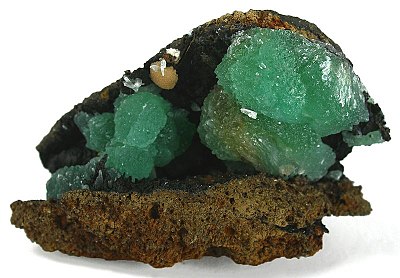Anapait
| Anapait | |
|---|---|
| Fan-shaped or rosette-shaped, greenish anapaite from Kerch , Crimea peninsula, Ukraine | |
| General and classification | |
| chemical formula | Ca 2 Fe 2+ [PO 4 ] 2 • 4 H 2 O |
|
Mineral class (and possibly department) |
Phosphates, arsenates and vanadates |
|
System no. to Strunz and to Dana |
8.CH.10 ( 8th edition : VII / C.19) 02/40/01/01 |
| Crystallographic Data | |
| Crystal system | triclinic |
| Crystal class ; symbol | pinacoidal 1 |
| Space group | P 1 |
| Lattice parameters |
a = 6.447 Å ; b = 6.816 Å; c = 5.898 Å, α = 101.64 °; β = 104.24 °; γ = 70.76 ° Please complete the source as an individual reference |
| Formula units | Z = 1 Please complete the source as an individual reference |
| Physical Properties | |
| Mohs hardness | 3.5 |
| Density (g / cm 3 ) | 2.8 to 2.81 |
| Cleavage | perfectly |
| Break ; Tenacity | uneven |
| colour | green, greenish white |
| Line color | White |
| transparency | transparent to translucent |
| shine | Glass gloss |
| Crystal optics | |
| Refractive indices |
n α = 1.602 n β = 1.613 n γ = 1.649 |
| Birefringence | δ = 0.047 |
| Optical character | biaxial positive |
| Axis angle | 2V = 52 to 56 ° |
Anapaite (also Tamanite ) is a seldom occurring mineral from the mineral class of water-containing phosphates without foreign anions . It crystallizes in the triclinic crystal system with the chemical composition Ca 2 Fe 2+ [PO 4 ] 2 • 4 H 2 O and develops either tabular crystals or spherical, rosette-shaped and granular aggregates of light to dark green color.
Etymology and history
Anapait was first found in an iron ore mine near Anapa in southern Russia in 1902 and examined by A. Sachs. He named it Anapait after the place where it was found . In 1903 a similar mineral was described by SP Popoff that he called Tamanite . However, it turned out that anapaite and tamanite are identical minerals. The name Anapait used first was retained.
classification
In the now outdated, but still in use 8th edition of the mineral classification according to Strunz , the anapaite belonged to the mineral class of "phosphates, arsenates and vanadates" and to the department of "water-containing phosphates without foreign anions ", where it was the only member of the independent group VII /C.19 formed.
The 9th edition of Strunz's mineral systematics, which has been in effect since 2001 and is used by the International Mineralogical Association (IMA), also assigns the anapait to the class of "phosphates, arsenates and vanadates" and there to the department of "phosphates, etc. without additional anions ; with H 2 O “. This section is, however, further subdivided according to the size of the cations involved and the ratio of the phosphate, arsenate or vanadate complex (RO 4 ) to the water of crystallization contained , so that the mineral is classified in the sub-section “With large and medium-sized cations; RO 4 : H 2 O <1: 1 “can be found, where it is the only member of the unnamed group 8.CH.10 .
The systematics of minerals according to Dana , which is mainly used in the English-speaking world , assigns the anapait to the class of "phosphates, arsenates and vanadates" and there in the department of "water-containing phosphates, etc.". Here he is to be found as the only member of the unnamed group 40.02.01 within the subdivision of " Water-containing phosphates etc., with A 2+ (B 2+ ) 2 (XO 4 ) × x (H 2 O) ".
Education and Locations

Anapaite is a so-called secondary mineral . It mainly forms in the oxidation zone of oolithic iron ores together with siderite and limonite , in the trunks of fossil trees or in lacustric sediments .
So far (as of December 2010) 22 sites are known. In addition to the type locality Anapa in Russia, these include Messel , Ehrenfriedersdorf and Sondheim in Germany, San Giovanni Valdarno and Cavriglia in Italy, Lake Malawi , Cromwell in New Zealand, Lleida in Spain, the Crimean peninsula in Ukraine as well as Corcoran , Lyon County and Groton / New Hampshire in the USA.
Crystal structure
Anapait crystallizes in a trikine crystal structure with the space group P 1 with the lattice constants a = 6.447 Ångström , b = 6.816 Å, c = 5.898 Å, α = 101.64 °, β = 104.24 ° and γ = 70.76 ° as well one formula unit per unit cell .
See also
Individual evidence
- ↑ a b c d Anapaite at mindat.org (engl.)
- ^ Paul Ramdohr , Hugo Strunz : Textbook of Mineralogy . 16th edition. Ferdinand Enke Verlag 1978, ISBN 3-432-82986-8 (p. 645)
- ↑ Stefan Weiß: The large Lapis mineral directory . 4th edition. Christian Weise Verlag, Munich 2002, ISBN 3-921656-17-6
- ↑ A. Sachs: The Anapait, a new limestone iron phosphate from Anapa on the Black Sea. In: Journal for Applied Chemistry. 15, 1902, p. 111, doi : 10.1002 / ange.19020150503 .
- ^ SP Popoff. In: Journal of Crystallography, Mineralogy and Petrography. 1903, 37, p. 267.
- ↑ Webmineral - New Dana Classification of hydrated Phosphates, etc.
literature
- Anapait in: Anthony et al .: Handbook of Mineralogy , 1990, 1, 101 ( pdf ).
- Petr Korbel, Milan Novák: Encyclopedia of Minerals . Nebel Verlag GmbH, Eggolsheim 2002, ISBN 3-89555-076-0 .
Web links
- Mineral Atlas: Anapaite (Wiki)
- Anapaite at mindat.org (Engl.)
- Webmineral - Anapaite (Engl.)
